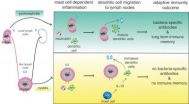(Press-News.org) The first animal model of recent human evolution reveals that a single mutation produced several traits common in East Asian peoples, from thicker hair to denser sweat glands, an international team of researchers reports.
The team, led by researchers from Harvard Medical School, Harvard University, the Broad Institute of MIT and Harvard, Massachusetts General Hospital, Fudan University and University College London, also modeled the spread of the gene mutation across Asia and North America, concluding that it most likely arose about 30,000 years ago in what is today central China. The findings are reported in the cover story of the Feb. 14 issue of Cell.
"This interdisciplinary approach yields unique insight into the generation of adaptive variation among modern humans," said Pardis Sabeti, associate professor in the Center for Systems Biology and Department of Organismic and Evolutionary Biology at Harvard University, and one of the paper's senior authors.
"This paper tells a story about human evolution in three parts," said Cliff Tabin, head of the HMS Department of Genetics and co-senior author. "The mouse model links multiple traits to a single mutation, the related association study finds these traits in humans, and computer models tell us where and when the mutation likely arose and spread."
Previous research in Sabeti's lab had identified the mutation as a strong candidate for positive selection. That is, evidence within the genetic code suggested the mutant gene conferred an evolutionary advantage, though what advantage was unclear.
The mutation was found in a gene for ectodysplasin receptor, or EDAR, part of a signaling pathway known to play a key role in the development of hair, sweat glands and other skin features. While human populations in Africa and Europe had one, ancestral, version of the gene, most East Asians had a derived variant, EDARV370A, which studies had linked to thicker scalp hair and an altered tooth shape in humans.
The ectodysplasin pathway is highly conserved across vertebrates — the same genes do the same thing in humans and mice and zebrafish. For that reason, and because its effects on skin, hair and scales can be observed directly, it is widely studied.
This evolutionary conservation led Yana Kamberov, one of two first authors on the paper, to reason that EDARV370A would exert similar biological effects in an animal model as in humans. The HMS research fellow in genetics developed a mouse model with the exact mutation of EDARV370A — a difference of one DNA letter from the original, or wild-type, population. That mouse manifested thicker hair, more densely branched mammary glands and an increased number of eccrine, or sweat, glands.
"This not only directly pointed us to the subset of organs and tissues that were sensitive to the mutation, but also gave us the key biological evidence that EDARV370A could have been acted on by natural selection," Kamberov said.
The findings prompted the team to look for similar traits in human populations. When co-first author Sijia Wang and the team including collaborators at Fudan examined the fingertips of Chinese volunteers at colleges and farming villages, they found that the sweat glands of Han Chinese, who carry the derived variant of the gene, were packed about 15 percent more densely than those of a control population with the ancestral variant.
At the same time, Wang and the team including collaborators at University College London were working to zero in on when and where the mutation arose. Computer models suggested that the derived variant of the gene emerged in central China between 13,175 and 39,575 years ago, with a median estimate of 30,925 years. Researchers concluded the derived variant is at least 15,000 years old, predating the migration from Asia by Native Americans, who also carry the mutation.
That time span suggests that different traits could have been under selection at different times. The mutation's many effects, known as pleiotropy, only complicate the question. If changes to the sweat glands conferred an advantage in new climates — one of the theories the researchers plan to explore further — changes to hair and to mammary glands could have conferred other advantages at other times.
Not all of these advantages need be direct effects on fitness. "When Pardis started this work, I would not have predicted that a gene that makes good hair would top of a list of mutations that confer evolutionary advantage among humans," said Bruce Morgan, HMS associate professor of dermatology at Massachusetts General Hospital and co-senior author on the paper. "However, in this case 'good hair' may have a biological meaning because it is genetically linked to a physiologically adaptive trait like increased sweating capacity. A cultural preference for a physically obvious trait like hair type could have arisen because individuals with it were more successful, and this would help increase selection on the new variant."
"That (pleiotropy) makes it harder for us to make a guess," Wang said. "If there were only one associated trait, we could say with confidence that's where the selective advantage comes from. But with many traits, we don't know which is the target of selection, and which are just hitchhiking." Wang intends to focus on that question in his new role, as a Max Planck independent research group leader in dermatogenomics at Chinese Academy of Sciences – Max Planck Partner Institute for Computational Biology in Shanghai.
By leveraging the power of diverse fields, the team is piecing together the foundation for understanding how selected mutations like EDARV370A have impacted human diversity. But, they say, this is only the beginning.
"These findings point to what mutations, when, where and how," said Daniel Lieberman, a professor of human evolutionary biology at Harvard University and a co-senior author on the study. "We still want to know why."
### END
First animal model of recent human evolution
2013-02-14
ELSE PRESS RELEASES FROM THIS DATE:
Defect in immune memory may cause repeat bladder infections
2013-02-14
DURHAM, N.C. – Recurrent bladder infections, which are especially common among women, may result from a defect among the bladder's immune fighters that keeps them from remembering previous bacterial infections. The immune memory lapse can hamper a timely and effective attack, according to researchers at Duke Medicine and Duke-National University of Singapore.
Their study, which involved mice, may provide a new route to develop vaccines and treatments for urinary tract infections, which are the second-most common infection and account for more than 8 million health care ...
Discovery in HIV may solve efficiency problems for gene therapy
2013-02-14
A research team from Case Western Reserve University School of Medicine has discovered an approach that could make gene therapy dramatically more effective for patients.
Led by professor Eric Arts, PhD, the scientists discovered that the process of gene therapy is missing essential elements thereby reducing the effectiveness of this treatment. Re-introducing this element into their model system suggests that improvements for gene therapy areon the horizon.
The findings are detailed in the article, "A new genomic RNA packaging element in retroviruses and the interplay ...
Study tracks leukemia's genetic evolution, may help predict disease course, tailor care
2013-02-14
BOSTON AND CAMBRIDGE, Mass.––Tumors are not factories for the mass production of identical cancer cells, but are, in reality, patchworks of cells with different patterns of gene mutations. In a new study, researchers at Dana-Farber Cancer Institute and the Broad Institute show, more fully than ever before, how these mutations shift and evolve over time in chronic lymphocytic leukemia (CLL) – providing a strobe-like look at the genetic past, present, and future of CLL tumors.
Their report, which will be published online today by the journal Cell, suggests that evolution ...
Gene invaders are stymied by a cell's genome defense
2013-02-14
Gene wars rage inside our cells, with invading DNA regularly threatening to subvert our human blueprint. Now, building on Nobel-Prize-winning findings, UC San Francisco researchers have discovered a molecular machine that helps protect a cell's genes against these DNA interlopers.
The machine, named SCANR, recognizes and targets foreign DNA. The UCSF team identified it in yeast, but given the similarity of yeast and human cells, comparable mechanisms might also be found in humans, where they might serve to lower the burden of inherited human disease and death, the researchers ...
Environment schemes for kids influence parents' behavior
2013-02-14
Teaching children about the environment can affect the knowledge and behaviour of their parents, according to new research.
Scientists from Imperial College London surveyed the families of 160 schoolchildren in the Seychelles, some of whom took part in educational activities about the island's valuable wetland resources.
They found that the parents of children who took part in the wetland activities were more knowledgeable about wetlands and, were more inclined to undertake 'environmentally friendly' behaviours such as conserving water in their homes.
The findings ...
Our primitive reflexes may be more sophisticated than they appear, study shows
2013-02-14
Supposedly 'primitive' reflexes may involve more sophisticated brain function than previously thought, according to researchers at Imperial College London.
The Vestibular-Ocular Reflex (or VOR), common to most vertebrates, is what allows us to keep our eyes focused on a fixed point even while our heads are moving. Up until now, scientists had assumed this reflex was controlled by the lower brainstem, which regulates eating, sleeping and other low-level tasks.
Researchers at Imperial's Division of Brain Sciences conducted tests to examine this reflex in left- and right-handed ...
Indian plant could play key role in death of cancer cells
2013-02-14
AUGUSTA, Ga. – Scientists at the Georgia Regents University Cancer Center have identified an Indian plant, used for centuries to treat inflammation, fever and malaria, that could help kill cancer cells.
Cancer cells typically avoid death by hijacking molecular chaperones that guide and protect the proteins that ensure normal cellular function and then tricking them into helping mutated versions of those proteins stay alive, says Dr. Ahmed Chadli, a researcher in the Molecular Chaperone Program at the GRU Cancer Center and senior author of the study named the Journal ...
New LA BioMed research identifies effective treatment for common gynecological problem
2013-02-14
LOS ANGELES (Feb. 14, 2013) – New research from the Los Angeles Biomedical Research Institute (LA BioMed) found a progestogen-only treatment halted bleeding in women suffering from extremely heavy periods, according to the study published online by the American Journal of Obstetrics and Gynecology.
"Excessive uterine bleeding is a common problem we see in gynecological practices and emergency rooms. It can interfere with women's daily activities and put them at risk for anemia and other more serious health consequences caused by blood loss," said Anita L. Nelson, MD, ...
Love of musical harmony is not nature but nurture
2013-02-14
Our love of music and appreciation of musical harmony is learnt and not based on natural ability – a new study by University of Melbourne researchers has found.
Associate Professor Neil McLachlan from the Melbourne School of Psychological Sciences said previous theories about how we appreciate music were based on the physical properties of sound, the ear itself and an innate ability to hear harmony.
"Our study shows that musical harmony can be learnt and it is a matter of training the brain to hear the sounds," Associate Professor McLachlan said.
"So if you thought ...
Dogs spot the dog
2013-02-14
Dogs pick out faces of other dogs, irrespective of breeds, among human and other domestic and wild animal faces and can group them into a category of their own. They do that using visual cues alone, according to new research by Dr. Dominique Autier-Dérian from the LEEC and National Veterinary School in Lyon in France and colleagues. Their work, the first to test dogs' ability to discriminate between species and form a "dog" category in spite of the huge variability within the dog species, is published online in Springer's journal Animal Cognition.
Individuals from the ...





